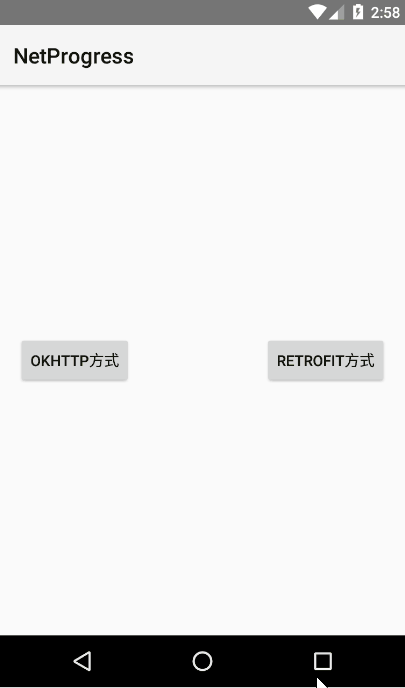起因
對于廣大Android開發者來說,最近用的最多的網絡庫,莫過于Okhttp啦(Retrofit依賴Okhttp)。
Okhttp不像SDK內置的HttpUrlConnection一樣,可以明確的獲取數據讀寫的過程,我們需要執行一些操作。
介紹
Retrofit依賴Okhttp、Okhttp依賴于Okio。那么Okio又是什么鬼?別急,看官方介紹:
Okio is a library that complements java.io and java.nio to make it much easier to access, store, and process your data.
翻譯過來就是,Okio是一個實現了java.io和java.nio的一個類庫,它讓連接,存儲,處理你的數據更加輕松~(Okio既是讀寫相關類庫,獲取進度要從Okio入手)。
好吧,對于廣大開發者來說,內心是這樣的:TM又要看你文檔和用例,按你規則走,輕松個毛啊!
其實,讀下API,看下Example熟悉后,人家設計的還是很棒噠。
廢話不多說,先看效果。
效果

實際代碼:
//添加下載攔截器(this參數是實現下載進度接口的對象) mDownClient = new OkHttpClient.Builder() //只需要一行代碼就行了 .addNetworkInterceptor(new DownloadInterceptor(this)) .build(); //添加上傳攔截器(this參數是實現上傳回調接口的對象) mUploadClient = new OkHttpClient.Builder() //只需要一行代碼就行了 .addNetworkInterceptor(new UploadInterceptor(this)) .build();
你只需要一行代碼是不行的!我為什么行?因為這是我寫的封裝類庫啊~(最后放地址)
思路
Okhttp依賴Okio進行了數據的讀寫動作,我們需要找到Okio進行處理。那么,如何加上呢?
Okhttp可以添加Interceptor(攔截器),我們可以通過攔截器的接口方法,獲取對應的responseBody、requestBody對象進行操作。然后我們就獲取了讀寫相關的實現方法。具體實現是通過Source、Sink對象。
Source官方解釋:Supplies a stream of bytes. Use this interface to read data from wherever it's located。
Sink官方解釋:Receives a stream of bytes. Use this interface to write data wherever it's needed。
一句話概括:Source對象是對輸入流的包裝(下載讀數據),Sink是對輸出流的包裝(寫數據上傳)。
實現
根據需要添加下載、上傳Interceptor
//添加下載攔截器(this參數是實現下載進度接口的對象) mDownClient = new OkHttpClient.Builder() .addNetworkInterceptor(new DownloadInterceptor(this)) .build(); //添加上傳攔截器(this參數是實現上傳回調接口的對象) mUploadClient = new OkHttpClient.Builder() .addNetworkInterceptor(new UploadInterceptor(this)) .build();
攔截器具體實現
//下載攔截器 public class DownloadInterceptor implements Interceptor {private OnDownloadListener mListener;public DownloadInterceptor( OnDownloadListener listener) { mListener = listener;}@Overridepublic Response intercept(Chain chain) throws IOException { //封裝ressponse對象 Response response = wrapResponse(chain.proceed(chain.request())); return response;}private Response wrapResponse(Response response) { if (response == null || response.body() == null) { return response; } //獲取處理后的response對象 Response wrapResponse = getWrapResponse(response); return wrapResponse;}private Response getWrapResponse(Response response) { ProgressInfo info = new ProgressInfo(); info.setTime(System.currentTimeMillis()+""); info.setUrl(response.request().url().toString()); Response.Builder builder = response.newBuilder(); //封裝responseBody,傳入相關參數,獲取進度數據回調 return builder.body(new WrapResponseBody(response.body(),info,mListener)).build();}} --------------------------------------分割--------------------------------------- //上傳攔截器 public class UploadInterceptor implements Interceptor {private OnUploadListener mListener;public UploadInterceptor(OnUploadListener listener) { mListener = listener;}@Overridepublic Response intercept(Chain chain) throws IOException { //封裝request對象 Request request = wrapRequest(chain.request()); Response response = chain.proceed(request); return response;}private Request wrapRequest(Request request) { if (request == null || request.body() == null) { return request; } Request.Builder builder = request.newBuilder(); ProgressInfo info = new ProgressInfo(); HttpUrl url = request.url(); info.setUrl(url.toString()); info.setTime(System.currentTimeMillis()+""); //封裝requestBody,傳入參數,獲取數據進度回調 builder.method(request.method(),new WrapRequestBody(request.body(),info,mListener)); return builder.build(); } }responseBody、requestBody相關實現//繼承ResponseBody實現具體方法public class WrapResponseBody extends ResponseBody {private Handler mHandler = new Handler(Looper.getMainLooper());private ResponseBody mResponseBody;private OnDownloadListener mListener;private ProgressInfo mInfo;private BufferedSource mBufferedSource;private boolean mDoProgress;//傳入進度,以及監聽對象public WrapResponseBody(ResponseBody responseBody, ProgressInfo info, OnDownloadListener listener) { mResponseBody = responseBody; mInfo = info; mListener = listener;}@Nullable@Overridepublic MediaType contentType() { //接口方法,返回類型 return mResponseBody.contentType();}@Overridepublic long contentLength() { long contentLength = mResponseBody.contentLength(); //gzip壓縮格式會返回-1,目前處理是在請求頭信息指定("Accept-Encoding","identity")表示不壓縮 if (contentLength == -1) { mDoProgress = false; mHandler.post(new Runnable() { @Override public void run() { //切換線程,進行失敗回調 mListener.onDownLoadGetContentLengthFail(mInfo); } }); } else { mDoProgress = true; } return contentLength;}@Overridepublic BufferedSource source() { //WrapSource(繼承ForwardingSource,ForwardingSource實現了Source接口) if (mBufferedSource == null) { mInfo.setContentLength(contentLength()); //傳入參數,讀取具體進度信息,并回調 WrapSource wrapSource = new WrapSource(mResponseBody.source(), mInfo, mListener,mDoProgress); mBufferedSource = Okio.buffer(wrapSource); } return mBufferedSource;}}--------------------------------------分割--------------------------------------- //繼承ResquestBody實現具體方法public class WrapRequestBody extends RequestBody {private RequestBody mRequestBody;private OnUploadListener mListener;private ProgressInfo mInfo;private boolean mDoProgress;private Handler mHandler = new Handler(Looper.getMainLooper()); //傳入進度,以及監聽對象public WrapRequestBody(RequestBody requestBody, ProgressInfo info, OnUploadListener listener) { mRequestBody = requestBody; mListener = listener; mInfo = info;}@Overridepublic MediaType contentType() { //接口方法,返回類型 return mRequestBody.contentType();}@Overridepublic long contentLength() throws IOException { try { //上傳內容長度,有異常走failWrok處理 long l = mRequestBody.contentLength(); mDoProgress = true; return l; } catch (IOException e) { e.printStackTrace(); failWork(); return -1; }}//進行失敗處理private void failWork() { mDoProgress = false; mHandler.post(new Runnable() { @Override public void run() { //切換線程,回調失敗信息 mListener.onUploadGetContentLengthFail(mInfo); } });}@Overridepublic void writeTo(BufferedSink sink) throws IOException { mInfo.setContentLength(contentLength()); // WrapSink (繼承ForwardingSink,ForwardingSink實現了Sink接口) ///傳入參數,讀取具體進度信息,并回調 WrapSink wrapSink = new WrapSink(sink, mInfo, mListener, mDoProgress); BufferedSink buffer = Okio.buffer(wrapSink); mRequestBody.writeTo(buffer); buffer.flush();}}WrapSource、WrapSink相關實現//繼承ForwardingSource 實現具體方法public class WrapSource extends ForwardingSource {private Handler mHandler = new Handler(Looper.getMainLooper());private Source mSource;private ProgressInfo mInfo;private OnDownloadListener mListener;private boolean mDoProgress;public WrapSource(Source source, ProgressInfo info, OnDownloadListener listener, boolean doProgress) { //傳入源Source、進度信息、監聽進度等信息。 super(source); mSource = source; mInfo = info; mListener = listener; //傳入是否繼續執行回調boolean參數,如果之前執行有異常,則不再繼續執行回調 mDoProgress = doProgress;}@Overridepublic long read(Buffer sink, long byteCount) throws IOException { //獲取具體進度信息,來到了熟悉的具體IO long read = super.read(sink, byteCount); if (read != -1) { long l = mInfo.getCurrentLength() + read; mInfo.setCurrentLength(l); mHandler.post(new Runnable() { @Override public void run() { if (mDoProgress) { //切換到主線程,回調數據 mListener.onDownLoadProgress(mInfo); } } }); } return read;}}--------------------------------------分割---------------------------------------//繼承ForwardingSink 實現具體方法public class WrapSink extends ForwardingSink {private Handler mHandler = new Handler(Looper.getMainLooper());public OnUploadListener mListener;public ProgressInfo mInfo;public boolean mDoProgress;public WrapSink(Sink delegate, ProgressInfo info, OnUploadListener listener, boolean doProgress) { //傳入源Source、進度信息、監聽進度等信息。 super(delegate); mInfo = info; mListener = listener; //傳入是否繼續執行回調boolean參數,如果之前執行有異常,則不再繼續執行回調 mDoProgress = doProgress;}@Overridepublic void write(Buffer source, long byteCount) throws IOException { super.write(source, byteCount); //獲取具體進度信息,來到了熟悉的具體IO long l = mInfo.getCurrentLength() + byteCount; mInfo.setCurrentLength(l); mHandler.post(new Runnable() { @Override public void run() { if (mDoProgress) { //切換到主線程,回調數據 mListener.onUpLoadProgress(mInfo); } } });}}總結
以上就是具體的流程了,按照步驟其實很簡單。大家了解下挺好的,我這邊也封裝好了具體的類庫和Demo,大家可以直接依賴(查看README.md,使用簡單)。
地址:https://github.com/HoldMyOwn/TNetProgress
以上就是本文的全部內容,希望對大家的學習有所幫助,也希望大家多多支持VEVB武林網。
新聞熱點
疑難解答